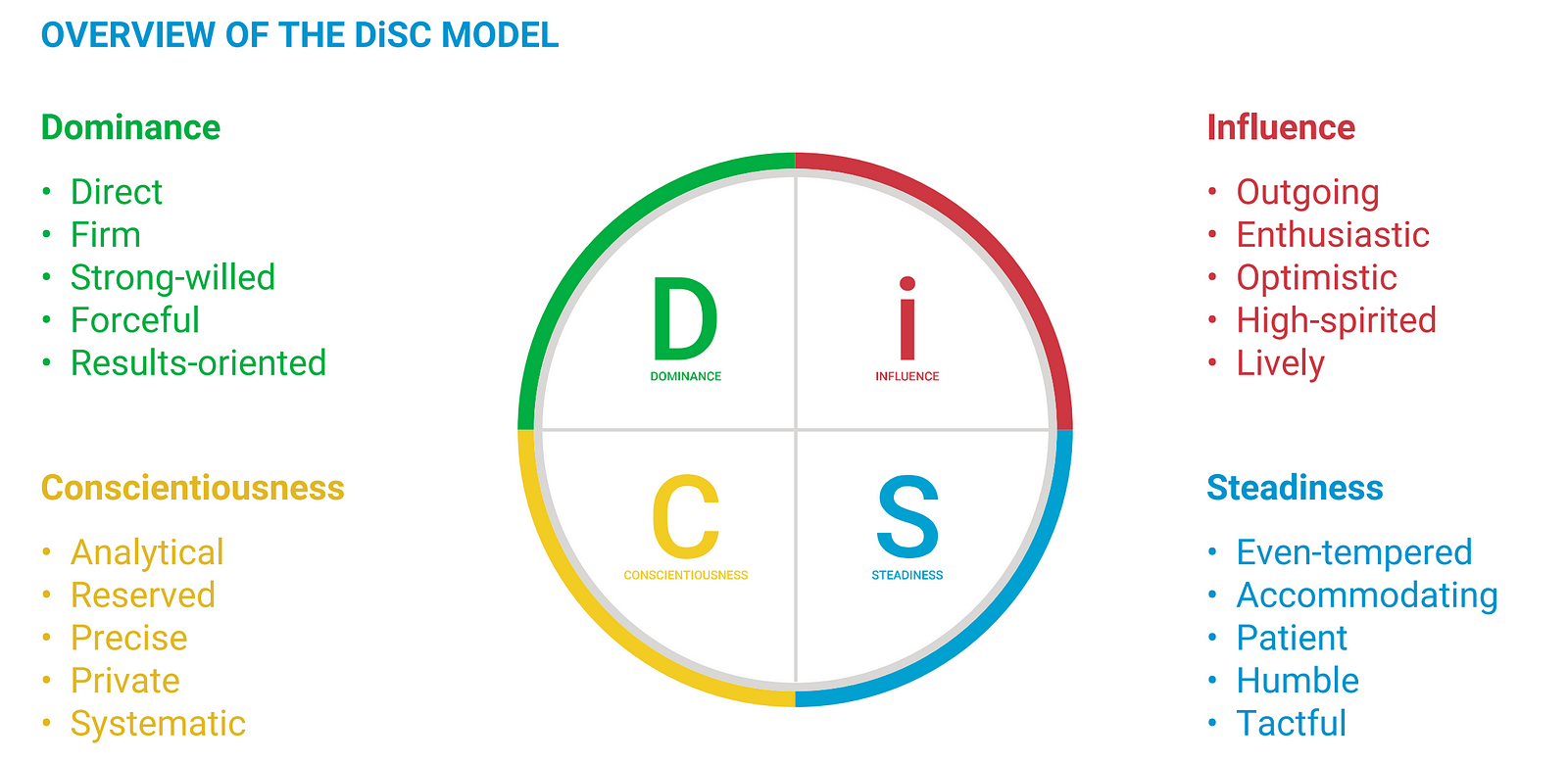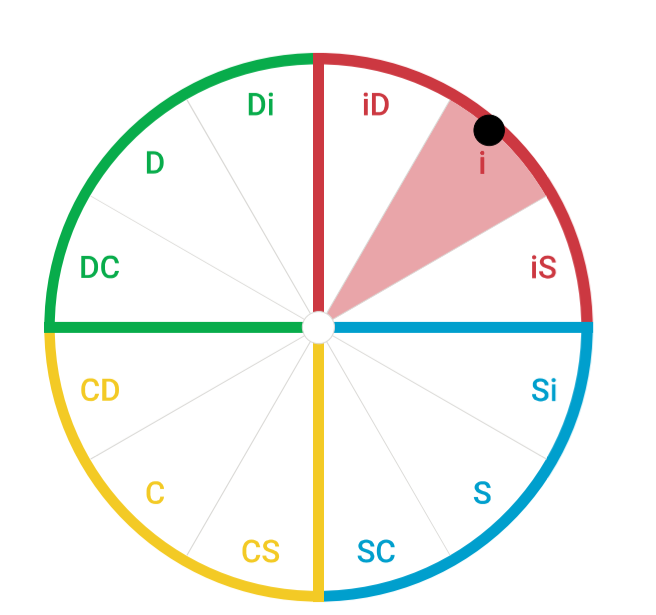And how to use DiSC to improve team performance, productivity and become a more effective leader
Seven years ago, my boss got everyone to complete a DiSC profile. The whole organisation completed the questionnaire and then sat through a facilitated workshop. It was the most important thing I have done on my leadership journey. Just last week, I completed my second DiSC profile assessment, and when I got my results back, I felt like a failure.

The DiSC profile is a process for categorising your behavioural style. D — Dominance, i — Influence, S — Steadiness, and C — Conscientious. It identifies your tendencies or preferences across a two-axis plot. The axes are controlled (do you like to be the one making decisions — the D and i profiles are high on control) and affiliation (do you prioritise decisions that the data says is right, or what the most people say is right — the i and S profiles are high on affiliation).
Your behavioural preferences are then characterised against those tendencies. There are no good or bad profiles, just differences, and everyone has a mix of all of the profiles. They just prioritise in one area. The below figure describes the preferences of each sector (there is commonality with “The Four Temperaments” and some overlap with Myers-Briggs).

I’ll explain why I felt like a failure after I explain a little bit more about DisC and why I think it is very important for improving organisational performance.
Understanding a DiSC report
Here are some of the key parts of my most recent DiSC report and what they mean.
The Cornerstone Principles of DiSC
All DiSC styles and priorities are equally valuable and everyone is a blend of all four styles;
- Your work style is also influenced by other factors such as life experiences, education, and maturity.
- Understanding yourself better is the first step to becoming more effective when working with others.
- Learning about other people’s DiSC styles can help you understand their priorities and how they may differ from your own.
- You can improve the quality of your workplace by using DiSC to build more
effective relationships.
These cornerstone principles resonate strongly with me. The primary reason it improves team performance is that it covers two fundamental areas; how you make decisions, and how you operate in teams. If you can understand this about yourself, and then understand it about your team, you will improve your team’s ability to achieve.
Here is an extract from the start of my DiSC report that gives you some indication of how it starts to improve your self-awareness.
Leon, have you ever wondered why connecting with some people is easier for you than with others? Maybe you’ve noticed that you relate better to colleagues who focus more on creating lively environments and relationships. Or, maybe you’re more comfortable working with those who take an optimistic, fast-paced approach than those who work at a steadier pace. Or, perhaps you relate best to people who are more enthusiastic than analytical.
All of these statements are true for me, some of them resonate more strongly than others and some of them are the reasons I feel like a failure.
Where do I fit?
When I completed the assessment seven years ago I fit into the sector of DiSC called ‘big i little D’. This means that I sat within the Influence quadrant, but on the border with the Dominance quadrant.
When I completed it this week, I sat in the middle of the Influence quadrant. I did not expect this to move overly much, but there was a reason why I felt like a failure. If you look at the below image you’ll note the word ring around the outside. This is where I prioritise my energy. The dot is where I sit on the assessment, right in the middle of the Influence quadrant. My priorities, on the outside ring, are enthusiasm, action and collaboration.

What this chart can also indicate is the amount of energy it takes to get to the other priorities around the ring. For instance, just because I do not have shading that covers accuracy, does not mean that I cannot make that a priority for me. It will take me some energy to get there and work there for extended periods, but I can prioritise accuracy. I often have to go into deep work mode to make it happen though. I have to expend energy away from my natural state.How to Focus Your Way to Success
Learn any skill, increase your productivity, and improve your work quality.medium.com
Why I felt like a failure and why you should complete an assessment
Something amazing happens after a team completes a DiSC assessment. A new language emerges, a new type of office banter. Ownership of individuals strengths and weaknesses emerges in the teams. The dynamic of the organisation shifts.
The thing that I struggled with is the position of my DiSC profile dot on the chart.

I knew that I would probably end up within the Influence segment, but what surprised me was how far from the middle of the chart I was. I’ll tell you why.
Failure?
My last DiSC assessment landed me in the iD segment, about three quarters out from the middle. Seven years later, I landed in the i segment and right out on the edge. This is the part that made me feel like a failure.
In the previous seven years I have worked hard to become increasingly self-aware, to make sure I regulate my interactions with my team and in meetings. To work hard to ensure I interact with people in the way that they prefer. I believed that I had become quite good at this.
When I received my latest DiSC profile, it appeared to show that I had not improved at all. I had moved further away from the centre. You see, I expected that with the focus I had placed on strengthening my connection with the other segments, that I would assess closer to the middle. I thought the effort would mean that I had moved myself to a place where I required less energy to interact with the other segments. I was wrong, and I felt like I had failed in my efforts to self-regulate.
After some reflection, however, I came to realise that it wasn’t a failure, I was thinking about it wrong. I believed that I could shift who I was by being a better communicator and integrator, by regulating my energy and being consciously inclusive. But, you can’t shift who you are, not without some truly life-changing moments.
What you can do, is strengthen your DiSC movement muscles. You can work out how to move segments more easily by continuously stretching yourself. What I have realised, over the last seven years, I have become better at moving around the quadrants depending on the environment I am in. By empathising with the people around me, and working out how best to connect with them, I have gotten better at moving around the quadrants. I cannot change who I am, but I can change how I interact and connect.
The power of DiSC
The DiSC framework is just a model to self-identify, then externally identify peoples methods of work. It has been the most significant assessment I have done, it has been pivotal in improving my effectiveness and productivity at work.
The primary reason why is that it gives you effective tips on how to navigate the quadrants. How to communicate, interact and make decisions with people who have different priorities to you. This allows you to self-regulate and empathise. By dampening your internal priorities and working to understand other people, you can communicate and integrate far more effectively.
It is this reason that I pushed to get my current work to conduct a DiSC assessment. We have already adopted the lingo, we have internalised the differences we own and acknowledged the differences in those around us. We have grown stronger together as a team because of this awareness.
For this reason, if you have team that is working well, but you know they are capable of more. You should invest in a DiSC assessment and workshop. This assessment can reduce friction and increase the productivity of your team. Their effectiveness will surge, their ability to realise that other people can add value to their work will increase, improving collaboration.
You can turn an effective team, into a high-performing team.
We intend to include coloured stickers (you’ll note the DiSC chart has a blue, red, yellow and green quadrant colour) and other identifiers to the office (charts stuck up on cubicles, additions to the signature block, etc.). This will normalise the understanding, make its acknowledgement explicit.
In summary, I felt like a failure because I thought I could change who I was. I couldn’t downplay my energy, my lean towards collaboration and action. These things are intrinsically me. I could, however, strengthen my empathy and connection muscles to allow me to work around the quadrant more effectively. This has allowed my effectiveness to increase.
You should investigate the DiSC dynamic in your team.
I’m a writer with a keen curiosity for people, human nature, leadership and growth. Originally published here.
